Class 4 laser therapy is a powerful medical treatment that utilizes a high-powered laser to promote healing in damaged tissues. Primarily targeting musculoskeletal conditions like arthritis, tendonitis, back pain, sports injuries, and wound healing, it offers effective relief and rehabilitation.
Class iv laser therapy can penetrate deep into the tissue and address diseases and injuries in deep muscles and bones. Compared to low-level laser devices, Class 4 lasers offer greater treatment depth and faster treatment speed, ensuring optimal therapeutic outcomes.
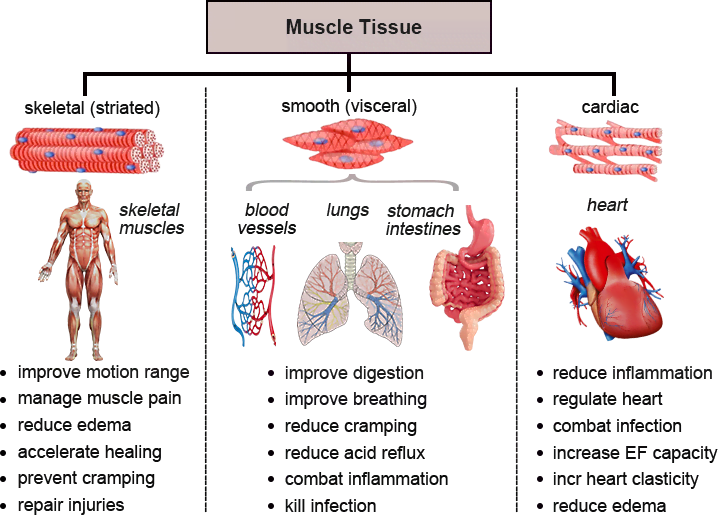
Class 4 laser therapy is a highly effective treatment for various types of pain, including arthritis, muscle pain, and neuralgia. By delivering high-energy light to body tissues, it stimulates local blood circulation and cell regeneration. This not only reduces pain but also accelerates the healing process, resulting in significant relief and improved well-being.
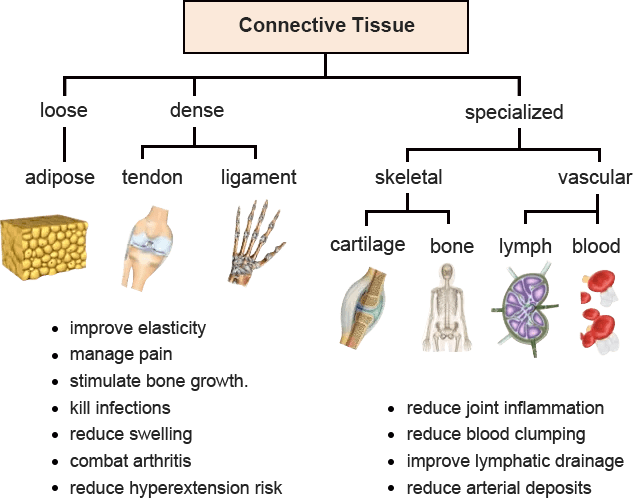
Class 4 laser therapy utilizes photobiomodulation to promote rehabilitation and treatment of sports injuries. By delivering high-energy light to damaged tissues, it stimulates local blood circulation, reduces inflammation and accelerates the recovery process. In addition, it can increase cell metabolism, enhance immune system function, and produce pain-relieving effects and other biological effects.
Class 4 laser therapy employs red and near-infrared light to enhance cellular energy and promote increased cell proliferation. This remarkable approach plays a pivotal role in fostering the healing of wounds and scar tissue reduction. It stimulates cellular metabolic processes and modulates signaling pathways responsible for wound repair. These pathways encompass crucial functions like cell migration, DNA synthesis, cell replication (mitosis), and protein secretion.
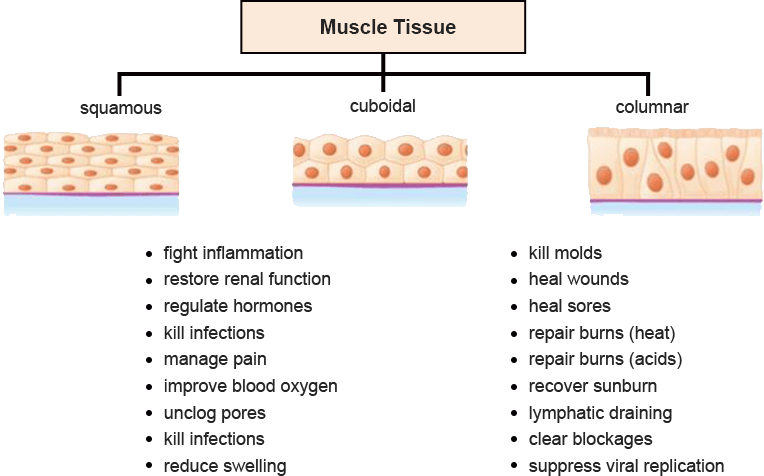
Class 4 laser therapy effectively alleviates nerve sensitivity by reducing the presence of bradykinin, a peptide chain known for promoting inflammation. This reduction in inflammation commonly results in decreased pain levels. Laser therapy offers a multi-faceted approach to pain management, including diabetic neuropathy, postherpetic neuralgia, and trigeminal neuralgia.
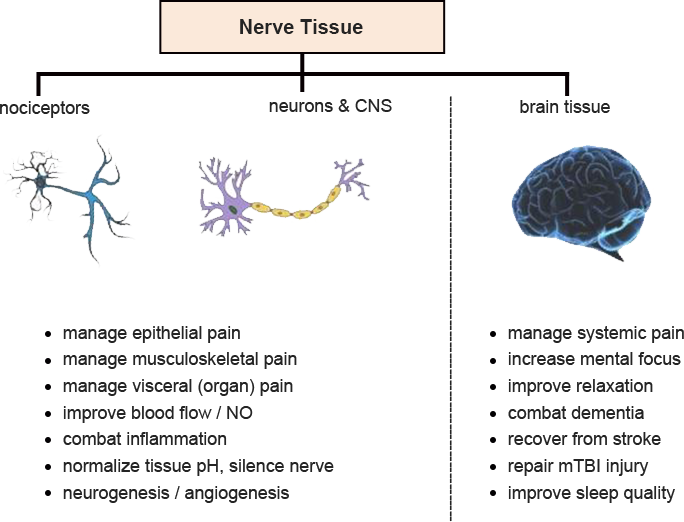
Class 4 laser therapy has shown potential for treating conditions like fibromyalgia, temporomandibular joint disorders, and migraines. Studies suggest that Class 4 laser therapy can reduce pain and improve function in patients with these conditions.
1. Pain (neck pain, back pain, shoulder pain, knee pain, etc.)
2. Arthritis
3. Sports injuries (sprains, strains, tendonitis, etc.)
4. Plantar fasciitis
5. Carpal tunnel syndrome
6. Fibromyalgia
7. Tennis elbow
8. Golfers elbow
9. Bursitis
10. Sciatica
11. Herniated disc
12. Frozen shoulder
13. TMJ disorder
14. Migraines/headaches
15. Peripheral neuropathy
16. Wound healing
17. Scar tissue reduction
CLINICALLY USED FOR
HIGH POWER LASER THERAPY
A NON-INVASIVE AND COMFORTABLE TREATMENT
Deliver the maximum results with Class IV laser therapy. This treatment uses a high-powered laser to penetrate into tissue, increasing blood flow and relieving pain. It can also enhance the healing process in muscles, bones, ligaments and tissues. Improve your quality of life with Class IV therapeutic laser!
Class IV laser treatment works by a process called photobiomodulation. The human tissues can absorb light photons and trigger a series of biological responses. The results of this treatment are: enhancing oxygenation in tissue, increased ATP production of cells and expanded blood vessels. Laser treatments vary drastically in terms of emitted light power.
Class IV laser therapy stands out among different forms of treatments. It has gained much popularity among those seeking effective healing solutions.
Benefits of a laser therapy system like SMART ICE may include:
Reduced pain: Many patients experience a significant decrease in pain levels after Class IV laser treatment.
Quicker recovery: The use of light photons allows for deeper tissue penetration, increasing cell energy and promoting faster nutrient absorption. This aids in the repair of ligaments, muscles, and tendon cells, fostering a quicker recovery process.
Greater penetration: Class IV laser treatment possesses increased laser light power, enabling light photons to reach deeper levels within the tissue. This is effective for addressing pain in muscles, tendons, and ligaments that is hard to handle by other treatments.
Less scarring: Laser therapy as a first option can help reduce the likelihood of requiring surgery, potentially minimizing scarring. It may also aid in reducing scar tissue formation.
Anti-Inflammatory Effects: Class IV laser therapy can enhance blood circulation through vasodilation, providing anti-inflammatory benefits and improving healing outcomes.
Rhein Laser’s laser therapy has passed FDA/CE/RoHS certification and meets strict ISO standards. We strictly adhere to international production standards, and our goal is to become a leader in the global laser therapy field.
With decades of clinical experience in laser therapy, we have successfully treated numerous patients with various conditions. Our professionals have amassed extensive expertise when it comes to providing effective laser therapies. From spinal cord injuries to chronic pain management, we have witnessed its great power first-hand. We stay at the forefront of advancements in laser technology, ensuring that patients receive the most advanced treatment options available.
More than half (up to 90% with lower wavelengths) of the laser energy is absorbed by the skin and subcutaneous tissue. Successful clinical outcomes for deeper conditions require treatment from lasers that have a higher wavelength and output. If the manufacturer did not engineer the therapeutic laser for continuous energy output from the beginning, then the laser is probably a surgical laser (designed to cut) converted to a therapeutic laser by pulsing energy output to avoid burning you. Pulsed lasers interrupt energy delivery reducing total dosage of energy when compared to continuous lasers given the same treatment duration.
Laser Therapy delivers light energy to promote tissue repair and growth. The Laser accelerates wound healing and decreases inflammation, pain, and scar tissue formation. Class IV Laser Therapy is a non-invasive and safe treatment for chronic pain management, wound healing and soft tissue repair.
Yes. Numerous clinical trials and research studies have verified its effectiveness across various conditions. These studies have shown positive outcomes in pain reduction, wound healing, improved tissue repair, decreased inflammation, and enhanced rehabilitation. Additionally, objective measurements such as imaging techniques also validate this. These scientific evidences underscore the efficacy and credibility of laser therapy as a safe and beneficial treatment modality.
The laser light interacts with tissues at the cellular level, leading to increased metabolic activity. This promotes enhanced energy production and improved cellular function. Laser therapy also facilitates increased circulation, allowing for better oxygen and nutrient delivery to cells and removal of waste products.
Additionally, it can stimulate the production of ATP, which plays vital roles in tissue repair. Overall, laser therapy triggers positive cellular responses that contribute to healing and improved physical functioning.
During each painless treatment, laser energy increases circulation, drawing water, oxygen, and nutrients to the damaged area. This creates an optimal healing environment for the reduction of inflammation, swelling, muscle spasms, stiffness, and pain.
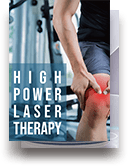
Learn more product information and immediately get the product manual
“Before using this machine, I had been suffering from muscle pain which caused discomfort and fatigue in my daily life. However, after using Rhein Laser’s class 4 laser therapy machine SMART ICE, my pain and discomfort significantly reduced, and I am now able to be more active and energetic in my daily routine.”
——Christopher Martin
“I also want to commend their customer service. Throughout the purchasing process, Rhein Laser’s staff provided me with ample help and support, and even gave me a satisfactory discount so that I could select the product that best suited my needs.”
——Ashley Rodriguez
Class 4 laser therapy is a treatment method that uses high-power lasers for pain relief. The therapeutic effect depends on the laser’s effect on human tissue.
Laser beams at specific wavelengths can induce biochemical reactions through the absorption of light energy. This stimulates ATP synthesis, enhance cell activity, reduce inflammation and promote tissue repair.
This stimulation can also cause cells to release various active substances such as oxygen free radicals, soluble mediators, and cytokines.
These substances can regulate immunity, relieve pain and inflammation, enhance nerve repair and functional recovery.
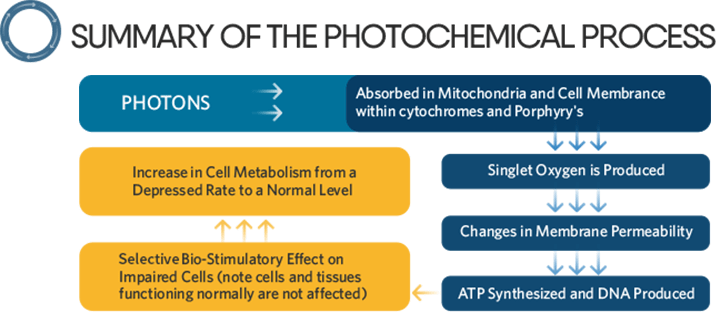
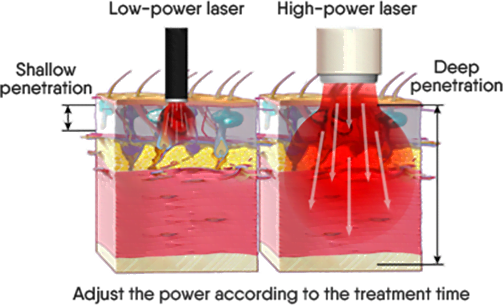
Both High-Level Laser Therapy (HLLT) and Low-Level Laser Therapy (LLLT) utilize laser light to produce therapeutic effects. They both aim to stimulate cellular processes, improve circulation, reduce inflammation, and aid in tissue repair and pain management.
However, there are great differences between them. Here’s a concise comparison:
Power Density: HLLT employs higher-power lasers (>500 mW) for deeper tissue penetration and potentially more significant therapeutic effects. LLLT uses lower-power lasers (<500 mW) for superficial conditions.
Treatment Parameters: HLLT requires shorter treatment durations due to higher power output. However, LLLT involves longer treatment durations with lower power densities. Parameters vary based on the specific condition.
Target Conditions: HLLT is suitable for deeper tissue penetration, such as musculoskeletal injuries and severe inflammatory conditions. LLLT is effective for superficial conditions, wound healing, and pain management closer to the skin surface.
Clinical Evidence: Both therapies have demonstrated efficacy, but HLLT has more extensive and well-established evidence. It’s more effective for musculoskeletal disorders, wound healing, and neuropathic pain with numerous clinical trials supporting its effectiveness. LLLT, while promising, has a relatively limited research base.
In summary, the choice between HLLT and LLLT depends on the condition and treatment goals. It’s better to consult with a healthcare professional to determine the appropriate approach.
Class 4 laser therapy is a medical treatment that uses a high-powered laser to relieve pain, reduce inflammation, and accelerate healing. It is typically used to treat conditions such as arthritis, back pain, tendonitis, and sports injuries. The laser delivers energy deep into the tissues, stimulating the body’s natural healing process. Unlike lower-class lasers, Class 4 lasers are able to penetrate deeply enough to reach muscles, bones, and other tissues. This makes them effective for treating both acute and chronic conditions.
Class 4 laser therapy is used in a variety of medical fields to treat a range of conditions. Some common applications include:
1. Pain management — It can be used to relieve pain caused by arthritis, back pain, sciatica, neuropathy, and other conditions.
2. Sports medicine — It can be used to treat sports injuries such as sprains, strains, and tendonitis.
3. Rehabilitation — It can be used to promote healing after surgery or injury, and to speed up recovery time.
4. Dermatology — It can be used to treat skin conditions such as psoriasis, eczema, and acne.
5. Dentistry — It can be used to treat tooth sensitivity, gum disease, and other oral conditions.
6. Veterinary medicine — It can be used to treat animals for pain, inflammation, and wound healing.
Class 4 laser therapy is suitable for people who are experiencing pain, inflammation, or a range of musculoskeletal conditions. It may be recommended by a healthcare professional as an alternative or adjunctive treatment to medication, physical therapy, or surgery.
The advantages of Class 4 laser therapy include:
1. Non-invasive — The treatment does not require incisions or injections, making it less invasive than many other treatments.
2. Pain relief — It can provide quick and effective pain relief, allowing patients to return to their normal activities sooner.
3. Reduced inflammation — It can help to reduce swelling and inflammation, which can promote faster healing.
4. Accelerated healing — It can stimulate the body’s natural healing processes, promoting tissue regeneration and reducing recovery time.
5. Versatility — It can be used to treat a variety of conditions in different areas of the body, making it a versatile treatment option.
The length of time required for Class 4 laser therapy varies depending on the patient’s condition and the area being treated. A typical treatment session may last between 5 and 20 minutes, although longer sessions may be necessary for more complex conditions.
The number of treatment sessions required will also depend on the patient’s individual response to the therapy, as well as the severity of their condition. Some patients may experience significant improvement after just one or two sessions, while others may require several weeks of regular treatments.
Class 4 laser therapy is generally considered safe and well-tolerated, with few side effects. However, some patients may experience mild discomfort during or after treatment, such as a sensation of warmth or tingling in the treated area.
There are usually no specific preparations required before receiving Class 4 laser therapy. However, it is recommended that patients wear loose-fitting clothing and avoid wearing jewelry or other items that may interfere with the treatment.
Patients should also inform their healthcare provider of any medications they are currently taking, as well as any medical conditions they have that may affect their response to the treatment.
It is also important to follow any instructions provided by the healthcare provider regarding the use of the laser, including how to position the body during treatment and how to protect the eyes from the laser light.
The effectiveness of Class 4 laser therapy is typically evaluated by assessing changes in pain levels, inflammation, and other symptoms before and after treatment. This may involve the use of visual analog scales or other standardized measures to quantify the patient’s response to the treatment.
Other factors that may be considered when evaluating the effectiveness of Class 4 laser therapy include improvements in range of motion, tissue healing, and overall quality of life.
The doctor will typically evaluate your medical history, current symptoms, and any previous treatments you have received to determine whether you are a candidate for Class 4 laser therapy. They may also perform a physical exam and other diagnostic tests to assess the severity and extent of your condition.
Based on this information, the doctor will develop a personalized treatment plan that is tailored to your individual needs and goals.
Typically, patients receive a series of treatments over a period of several weeks, with each session lasting between 5 and 20 minutes. The time interval between treatments is typically one to two times per week, although this may vary depending on the patient’s response to the treatment and the nature of their condition.
Class IV laser therapy typically does not have a significant impact on the patient’s daily life, and most patients are able to resume their normal activities immediately following treatment. However, some patients may experience mild discomfort or soreness after treatment, and it may be recommended that they avoid strenuous activity or exercise for a brief period of time.
The cost of Class 4 laser therapy will vary depending on the specific treatment plan and the healthcare provider offering the treatment. Some providers may offer package deals or discounts for multiple sessions, while others may charge a flat fee per session.
It’s a perfectly safe and effective procedure. Making the most of modern technology, it uses precise equipment to provide a level of treatment that would be all but impossible when completed using traditionally methods. This therapy changes the environment in the gum pocket through removal of inflamed tissue and root surface calculus/tartar to promote healthy tissue regeneration.
Laser therapy has been shown to be effective in reducing pain and inflammation in patients with back pain. The therapy works by utilizing a focused beam of light to penetrate deep into the tissues, stimulating cellular repair and regeneration through photobiomodulation. This results in increased blood flow and oxygenation in the treated area, as well as the release of endorphins, natural painkillers produced by the body.
Photobiomodulation (PBT) is the treatment application of photogenic energy, which is used to fight diseases, repair damage, relieve pain, manages organ and immune system dysfunction, reduce inflammation, and solve various nerve and age -related health problems.
PBT is also used to prevent diseases, prevent damage, improve brain health and cognition, promote health, and improve the performance of exercise and track and field movements.
As a key component of continuous expansion of optical medicine. Photobiomodulation (PBT, PBMT) intentionally stimulates the beneficial physiological role of cells, tissues and organs. PBT treatment may include medical treatment for the treatment of diseases, damage, organ dysfunction, and autoimmune diseases, including inflammation, pain management and wound healing.
Scientific Support
Abstracts Worth Recommending
[1] Sadick NS. Laser treatment with a 1064-nm laser for lower extremity class I-III veins employing variable spots and pulse width parameters. Dermatol Surg. 2003 Sep;29(9):916-9. doi: 10.1046/j.1524-4725.2003.29250.x. PMID: 12930332.
[2] Suter VGA, Sjölund S, Bornstein MM. Effect of laser on pain relief and wound healing of recurrent aphthous stomatitis: a systematic review. Lasers Med Sci. 2017 May;32(4):953-963. doi: 10.1007/s10103-017-2184-z. Epub 2017 Mar 27. PMID: 28345122.
[3] Martins DO, Santos FM, Britto LR, Lemos JB, Chacur M. Neurochemical effects of photobiostimulation in the trigeminal ganglion after inferior alveolar nerve injury. J Biol Regul Homeost Agents. 2017 Jan-Mar;31(1):147-152. PMID: 28337884.
[4] Janiszewski M, Furmańska-Rozlau A. An evaluation of laser photobiostimulation as a factor supporting rehabilitation in spinal pain syndromes. Ortop Traumatol Rehabil. 2000 Jun 30;2(2):69-71. PMID: 18034124.
[5] Liebert A, Capon W, Pang V, Vila D, Bicknell B, McLachlan C, Kiat H. Photophysical Mechanisms of Photobiomodulation Therapy as Precision Medicine. Biomedicines. 2023 Jan 17;11(2):237. doi: 10.3390/biomedicines11020237. PMID: 36830774; PMCID: PMC9953702.
[6] Larkin KA, Martin JS, Zeanah EH, True JM, Braith RW, Borsa PA. Limb blood flow after class 4 laser therapy. J Athl Train. 2012 Mar-Apr;47(2):178-83. doi: 10.4085/1062-6050-47.2.178. PMID: 22488283; PMCID: PMC3418129.
[7] Medina-Porqueres I, Cantero-Tellez R. Class IV laser therapy for trapeziometacarpal joint osteoarthritis: Study protocol for a randomized placebo-controlled trial. Physiother Res Int. 2018 Apr;23(2):e1706. doi: 10.1002/pri.1706. Epub 2018 Mar 9. PMID: 29520953.
Professional CLASS 4 high-power laser therapy machine
Portable handheld cold laser therapy device
Laser therapy machine, shockwave physical therapy, widely used in animals
subscribe us
Contact us